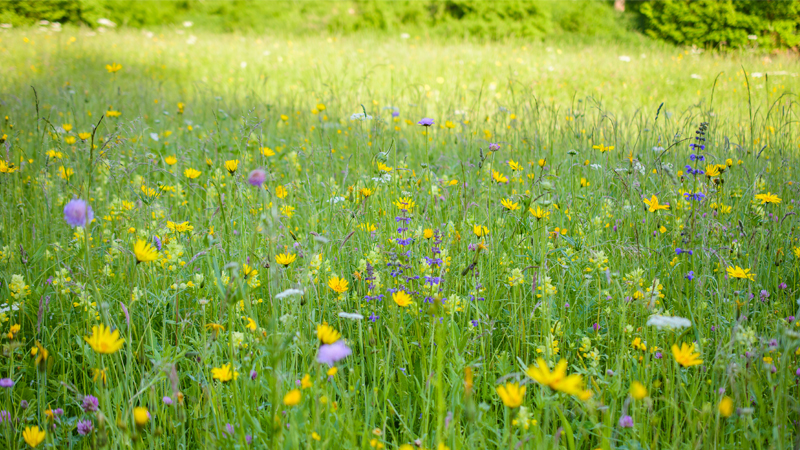A species-rich meadow provides habitats for butterflies, wild bees, grasshoppers and other insects. (Dominic Hahn / BUND BW)
“With our new project and associated exhibition, we want to draw attention to the fact that flowering hay meadows are a particularly important but endangered habitat in Baden-Württemberg,” explains Sylvia Pilarsky-Grosch, state president of the BUND. “The colorful hay meadows provide a habitat for up to 70 different plants and hundreds of species of butterflies, wild bees and other animals.”
The death of insects and the growing population decline of many other plants and animals highlight the urgent need for action and education. “Species-rich meadows are important for preserving our biodiversity. These natural havens, rich in herbs and herbs, were created through extensive agriculture that respects nature. It is therefore particularly important for me to help farms to continue this traditional farming method in the future for the benefit of nature and the cultural landscape “, emphasizes the Minister of the Environment of Baden-Württemberg, Thekla Walker.
Intensive agriculture and land use as a threat
There are two main reasons for the loss of flowering hay meadows today. On the one hand there is the intensification of agriculture and, on the other hand, the use of land by buildings and road traffic. Both causes have their origin in our society. Preserving species-rich hay fields is not possible without farmers. But in order for them to continue to cultivate their lawns with the goal of biodiversity, sufficient funding rates are needed.
Dialogue with farmers
Many farmers are already making a significant contribution to the conservation of flowering hay meadows by extensively cultivating their meadows. With its project and the new traveling exhibition, the BUND not only wants to provide information on the habitat in bloom, but also to win over farmers for this type of management and look for good roads with them.
At the main agricultural festival, conservationists want to discuss things with interested visitors. A richly illustrated exhibition can be expected, which is complemented by multimedia and interactive content. In the realization of the exhibition, the BUND also addressed the important issue of accessibility. The texts of the exhibition are therefore also explained in simple language. You can also listen to the contents of the exhibition. Visitors decide for themselves whether they want to explore the blooming habitat in plain language, standard language or texts read aloud.
“We want to excite visitors about the unique meadow habitat and show what everyone can do to preserve the species-rich hay meadows,” describes Sylvia Pilarsky-Grosch. “We look forward to numerous visitors and their questions. Not only does the climate crisis need immediate action, but also the biodiversity crisis “.
background
to the hay meadows
The once very common and species-rich hay meadows have been under European protection since 1992 and are still under threat. The two habitats, poor lowland hay meadows and mountain hay meadows, have been included in the Fauna-Flora-Habitat Directive due to their great importance, especially for insects and birds, and have therefore been placed under protection throughout Europe from EU Commission.
Baden-Württemberg has particularly diverse, species-rich and many hay meadows. That is why the state, together with Bavaria, has a special responsibility for the conservation of these habitats throughout Europe. In December 2021, the EU Commission filed a lawsuit against Germany because the hay fields were not adequately protected and many areas are still lost. The case also concerns Baden-Württemberg. If Germany fails to protect these habitats, there is a risk of high fines.
In Baden-Württemberg alone, about 6,700 hectares of species-rich hay fields have been lost since 2006. However, not only should Baden-Württemberg not have to lose areas during this period, it should also have secured and restored another 5,000 hectares under the Habitats Directive. Today we are far from a good state of conservation of these biodiversity hotspots.
to the BUND project
With its new project “Flowering hay meadows – agriculture for nature conservation”, BUND Baden-Württemberg wishes to draw attention to the danger and high ecological importance of species-rich meadows through active public relations at the state level. and educational work and increase acceptance and readiness for extensive management of species-rich grasslands. This project aims to pave the way for these lawns in the state to become more species-rich, colorful and diverse again. The project is funded by the Ministry of the Environment of Baden-Württemberg and has a duration of one year.
BUND Baden-Württemberg is looking for common solutions through specialist dialogues with farmers, conservationists, municipalities, districts and the state government in order to preserve the species-rich hay meadows. Lectures and round tables will be held. A traveling exhibition makes the grassland habitat tangible for families and nature lovers. The BUND also caters to teachers and educators with teaching materials and also trains orchard and wild herb educators and butterfly guides to become meadow ambassadors.
The exhibition in brief
- Was: Traveling exhibition “Hay meadows in bloom – agriculture for nature conservation”
- Wo: 101 ° LWH, Canstatter Wasen (stand 5.134 (hall 5))
- Self: 25/09 to 03.10.2022, from 9:00 to 18:00
More information
Contact for questions
- Sylvia Pilarsky-Grosch, State President of the Bund für Umwelt und Naturschutz Deutschland (BUND), Landesverband Baden-Württemberg, Sylvia.Pilarsky-Grosch (at) bund.net, 0172/83 44 294
- Dominic Hahn, coordinator of the “Blooming Hay Meadows” project, BUND Baden-Württemberg, dominic.hahn (at) bund.net, 0162 9677 444
To the overview
–


